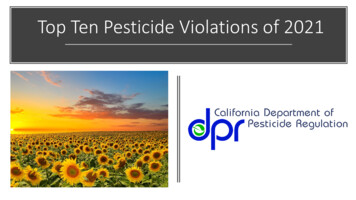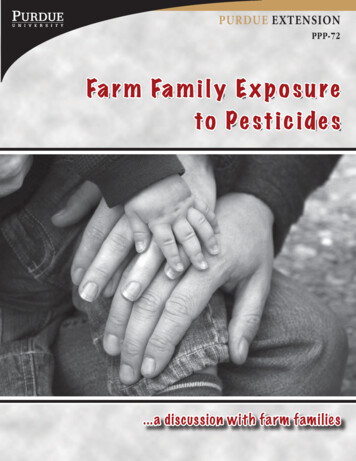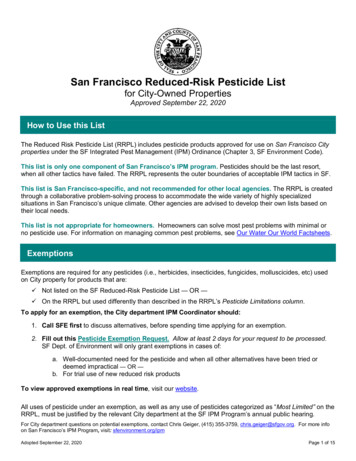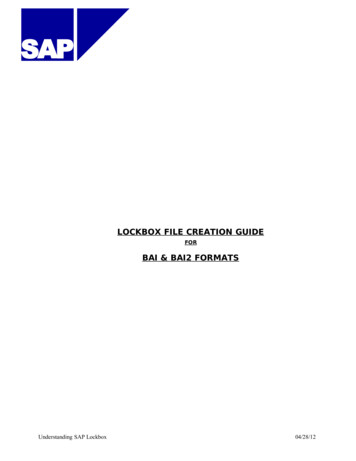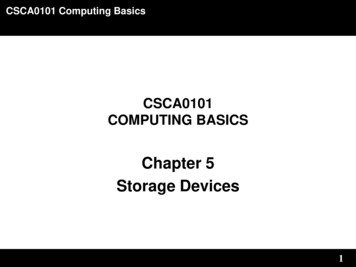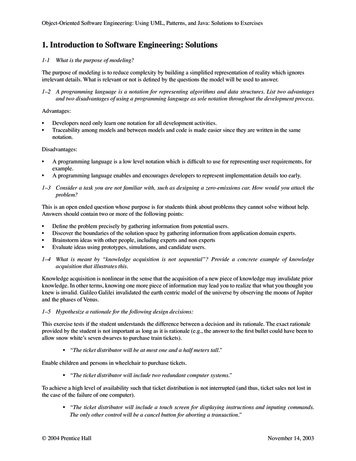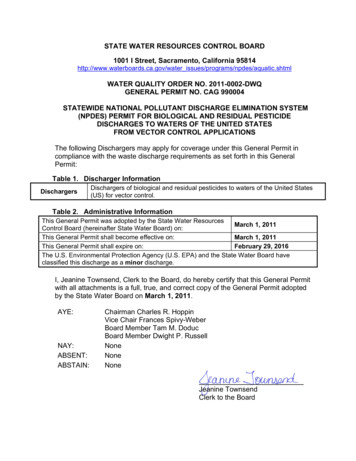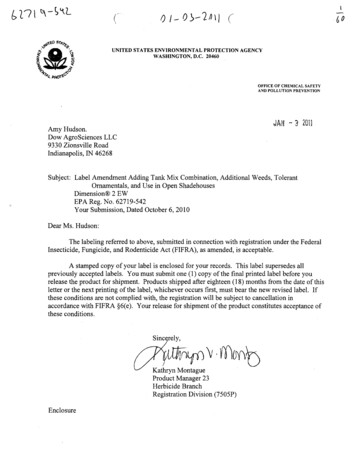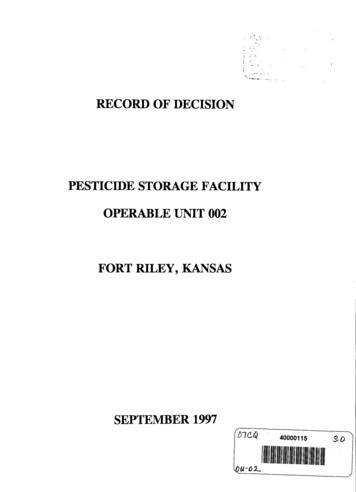
Transcription
RECORD OF DECISIONPESTICIDE STORAGE FACILITYOPERABLE UNIT 002FORT RILEY, KANSASSEPTEMBER 1997
TABLE OF CONTENTS1.0DECLARATION2.0DECISION SUMMARY2.1SITE NAME, LOCATION, AND DESCRIPTION2.2SITE HISTORY AND REMEDIAL ACTIVITIES2.3HIGHLIGHTS OF COMMUNITY PARTICIPATION2.4SCOPE AND ROLE OF OPERABLE UNIT2.5SUMMARY OF SITE CHARACTERISTICS2.63.02.5.12.5.2Surface and Subsurface SoilsGroundwater2.5.3Surface Water and SedimentsSUMMARY OF SITE RISKS2.6.1 Baseline Risk Assessment2.6.2 Residual Risk Assessment2.6.3 Effectiveness of the Removal Action2.6.4 Ecological Risk AssessmentRESPONSIVENESS SUMMARY2536-0308.27- i-
LIST OF FIGURESFigure2-1Pesticides Storage Facility Location Map2-2Pesticide Storage Facility -19922-3Pre-Removal Action Distribution of Pesticides in Surface Soils2-4Final Removal Action Excavations2-5Remaining Soil Samples Exceeding Removal Action RemedialLIST OF TABLESTable2-1Comparison of Pre-Removal and Post-Removal Action Positive Analytical Resultswith Removal Action Goals2-2Summary of Chemicals of Concern for the BLRA2-3Exposure Pathway Summary for the BLRA2-4Toxicity Values for Noncarcinogenic Effects2-5Toxicity Values for Potential Carcinogenic Effects2-6Exposure Pathway Summary for the RRA2-7Summary of Hazard Indices2-8Summary of Cancer RisksATTACHMENTFort Riley Master Plan - Land Uses
1.0 DECLARATIONSITE N A M E AND LOCATIONPesticide Storage Facility, Operable Unit 002Federal Facility Site - Fort Riley, KansasSTATEMENT OF BASIS AND PURPOSEThis Record of Decision document presents the selected remedial action for the Pesticide StorageFacility, Operable Unit 002, at Fort Riley, Kansas, chosen in accordance with the ComprehensiveEnvironmental Response, Compensation, and Liability Act of 1980 (CERCLA), as amended bythe Superfund Amendments and Reauthorization Act of 1986 (SARA), and to the extentpracticable, the National Oil and Hazardous Substances Pollution Contingency Plan (NCP). Thisdecision is based on the Administrative Record for the site.This remedy was chosen by the Department of the Army and Fort Riley, in consultation with theUnited States Environmental Protection Agency, Region VII (USEPA) and the KansasDepartment of Health and Environment (KDHE). The State of Kansas concurs with the selectedremedy via a letter of concurrence.DESCRIPTION OF THE SELECTED REMEDYThe selected remedy for the Pesticide Storage Facility, Operable Unit 002, at Fort Riley is NoFurther Action. A Removal Action in which contaminated soils were excavated, transported, anddisposed off-site was completed in 1994. Based upon current and projected industrial land use atthe site and the populations that may be exposed to site contamination, it has been determinedthat the site does not pose a significant threat to public health, welfare, and the environment.If a significant change in land use at the PSF is proposed by Fort Riley, or if any portion of thesite property is transferred or leased to a non-government entity, Fort Riley will notify RegionVII of the U.S. Environmental Protection Agency (EPA) and the Kansas Department of Healthand Environment (KDHE) in writing of the proposed change in land use or transfer of lease ofthe property or a portion of the property. If the change in land use is determined to be a majorchange in land use, a reevaluation of the remedy decision will be required. Depending upon thenature of the transfer or lease of the site property, EPA and/or KDHE may require Fort Riley toreconsider the no further action decision selected in this Record of Decision, which may requirethe implementation of additional response actions, including institutional controls, prior to thetransfer or lease of site property.Fort Riley, KansasOperable Unit 0021-1Record of DecisionPesticide Storage FacilitySeptember 1997
DECLARATION STATEMENTAt this time, no further remedial action is necessary for Operable Unit 002, the Pesticide StorageFacility to ensure protection of human health and the environment. Section 300.430(f) (4) (ii) ofthe National Oil and Hazardous Substances Pollution Contingency Plan (NCP) states that if aremedial action is selected that results in hazardous substances, pollutants or contaminantsremaining at a site above levels that allow for unlimited use and unrestricted exposure, the leadagency shall review such action no less often than every five years after initiation of the selectedremedial action. Although the decision reached in the Record of Decision is no further action,this decision is based upon current and reasonably projected land use and exposures. However,hazardous substances, pollutants or contaminants may remain at the site above levels that wouldallow for unlimited use and unrestricted exposure. Therefore, the five year review will apply tothis site.Fort Riley, KansasOperable Unit 0021-2Record of DecisionPesticide Storage FacilitySeptember 1997
LEAD AND SUPPORT AGENCY ACCEPTANCE OF THE RECORD OF DECISION,OPERABLE UNIT 002, PESTICIDE STORAGE FACILITYFT. RILEY, KANSASSignature Sheet for Record of Decision for Operable Unit 002, Pesticide Storage Facility, FortRiley, Kansas, Final Action."c\\c\r\A K ntT") ThonjasThnrri k ColonelKent D.Garrison Commander, Fort RileyUnited States Department of the ArmyTint?DateVEP29 1997inis Grams, P.E.1/DennisRegional AdministratorU.S. Environmental Protection Agency - Region VIIFort Riley, KansasOperable Unit 0021-3DateRecord of DecisionPesticide Storage FacilitySeptember 1997
2.0 DECISION SUMMARY2.1 SITE NAME, LOCATION, AND DESCRIPTIONPesticide Storage Facility, Operable Unit 002Fort Riley, KansasFort Riley (the installation) is situated along the north bank of the Kansas and Republican Riversin Riley and Geary counties in north-central Kansas (Figure 2-1). The installation is comprisedof approximately 101,000 acres. It lies within the Osage Plains section of the Central Lowlandsphysiographic province. The general topography around Fort Riley consists of plains incised bysteep drainage features. Terrain on the installation varies among the following features: (1)narrow, alluvial bottomlands and wide, meandering floodplains and associated terraces along theRepublican and Kansas Rivers; (2) steep slopes and hilly relief; and (3) flat-lying or slightlydipping uplands.The Pesticide Storage Facility (PSF) site (the site) is situated on a terrace on the north side of theKansas River Valley, approximately 2,000 feet north and west of the Kansas River. The PSF sitecovers about 2/3 of an acre around Building 348 and is located in the Main Post Area. The areaof investigation is indicated on Figure 2-2. The site includes a portion of the Public Works(formerly Directorate of Engineering and Housing [DEH]) Storage Yard, which is surrounded bya fence and has secured access. The site extends south of Dickman Avenue to the south-centraledge of the Main Post cantonment area and southeast across the railroad tracks. The entire site iswithin a zone designated as Industrial use in the Fort Riley Master Plan. (See attached Main Postarea land use zone map.) Topographic elevations at the site are about 25 feet higher than theKansas River. The ground surface east of the Building 348 fence slopes downward toward theeast-southeast at a grade of approximately 10 percent. There is an abrupt slope change just eastof the PSF fence line.Surface run-off across the site generally flows east - southeast as sheet flow, following thetopography of the site. After flowing around Buildings 345, 346, 347, and 348, the surface runoff is directed to a 12-inch corrugated metal pipe culvert that discharges via overland drainageinto the rock-lined channel east of the yard area. The lined drainage ditch runs from DickmanAvenue to the railroad tracks southeast of the site. The sides of the drainage ditch areconstructed of cemented limestone blocks. Surface run-off in this channel proceeds southwardunder the railroad tracks and then flows into an unnamed tributary leading to the Kansas River.Fort Riley, KansasOperable Unit 0022-1Record of DecisionPesticide Storage FacilitySeptember 1997
2.2 SITE HISTORY AND REMEDIAL ACTIVITIESFort Riley was established in 1852, as an outpost near the confluence of the Republican andSmoky Hill Rivers. Since its inception, Fort Riley has continually served as a major center ofmilitary education and readiness, at times including a population of more than 20,000 militaryresidents and civilian employees. The Fort Riley reservation historically has functioned both as asmall municipality and light industrial complex. Solid waste disposal (landfilling), wastewatertreatment and discharge, facilities maintenance and construction, pesticide and herbicide usage,and electrical equipment installation, storage, and repair, are among the environmentallysignificant activities at Fort Riley. Fort Riley's function as a military training, equipment supply,and maintenance center historically has required management and disposal of wastes associatedwith these activities.Building 348 was constructed in 1941 as a general purpose warehouse. Fort Riley records do notindicate when pesticides were first stored in Building 348. However, interviews with Fort Rileypersonnel reveal that Building 348 had been used for pesticide storage since at least 1973. Priorto the late 1970s, the maintenance/storage yard east of and adjacent to Building 348 was used towash down vehicles and spray equipment used for pesticide applications. Since at least 1976, themajority of pesticide application at Fort Riley has been performed by outside contractors whowere not allowed to use the PSF site. During 1988, several polychlorinated biphenyl (PCB)containing electrical transformers were stored in containers outside the southeast corner ofBuilding 348. Other items previously stored at the PSF site include paint, pesticides/herbicides,pressure-treated lumber, and various general improvement materials and equipment.Pursuant to Section 105 of the Comprehensive Environmental Response, Compensation, andLiability Act of 1980 (CERCLA), as amended by the Superfund Amendments andReauthorization Act of 1986 (SARA), Fort Riley was proposed for inclusion on the NationalPriorities List (NPL) on July 14, 1989. There are currently five identified Operable Units (OUs)at Ft. Riley. Two sites at Fort Riley, the PSF site and Southwest Funston Landfill, werecombined by the U.S. Environmental Protection Agency (USEPA) as one site for purposes ofHazard Ranking System (HRS) scoring. The USEPA reasoned that both contaminant sourcespotentially affect the same shallow aquifer and target populations. The installation was placedon the NPL as of October 1990, with a combined score of 33.79 on the HRS. (A HRS score of28.5 is needed for inclusion on the NPL.)The Department of the Army - Fort Riley, the USEPA Region VII, and the State of KansasDepartment of Health and Environment (KDHE) negotiated a Federal Facilities Agreement(FFA) for Fort Riley, Docket No. VII-90-F-0015, also referred to as the Interagency Agreement(IAG), which became effective on June 28, 1991. The FFA specifically requires that the PSF sitebe addressed through the Remedial Investigation/Feasibility Study (RI/FS) process. Consistentwith the National Contingency Plan (NCP) §300.415, the FFA also allows the Army to performRemoval Actions concurrent with RI/FS activities. The following documents were prepared inaccordance with the FFA:Fort Riley, KansasOperable Unit 0022-2Record of DecisionPesticide Storage FacilitySeptember 1997
RI Report (December 1993)Removal Action Engineering Evaluation/Cost Analysis Report (EE/CA)(August 1993)Removal Action Memorandum (December 1993)RI Addenda (June 1997)Proposed Plan (July 1997)Site contamination at the PSF site was first revealed by Army pesticide use monitoring studiesconducted prior to 1990. Fort Riley initiated planning of the RI/FS in 1990 during thedevelopment of the FFA. Field activities began in the early spring of 1992. The results of the RIand a Baseline Risk Assessment (BLRA) were presented in the RI Report.Concurrent with the performance of the RI and BLRA activities, the opportunity to perform anon-time-critical Removal Action addressing contaminated soils was recognized. An EE/CAwas performed to: (1) determine if a Removal Action was appropriate to protect human healthand the environment; (2) identify, evaluate, and recommend options for a Removal Action whichcould be incorporated into a permanent solution to remediate the site; and (3) develop a remedythat meets the occupational safety and health requirements of site workers and allows continuinguse of the site.The public comment period for the EE/CA was held August 17, through September 16, 1993. Apublic meeting was held at Fort Riley on September 7, 1993. No comments were receivedduring the public comment period. Subsequent to the finalization of the EE/CA, the RemovalAction Memorandum was signed. The Action Memorandum Decision was to excavate anddispose of contaminated soil off-site. The USEPA and KDHE concurred with the RemovalAction.The initial Removal Action Goals (goals), presented below, were generated from exposurescenarios for future site workers developed in the BLRA. These goals were extremelyconservative, as they were based on a carcinogenic risk level of 10" and the assumption that 100percent of the chemical in contact with the skin would be absorbed. Additional exploratorysampling of the site revealed a greater than anticipated area of contamination based on the initialRemoval Action Goals, a factor which would significantly increase the cost for remediation.With the exception of heptachlor, which was not a "risk driver", the Removal Action Goals forthe pesticides were recalculated using more realistic dermal absorption factors. The RemovalAction Goals for arsenic were revised based on results of a background study. These revisedGoals are presented below.6Fort Riley, KansasOperable Unit 0022-3Record of DecisionPesticide Storage FacilitySeptember 1997
Revised Absorption Factors and Removal Action GoalsCONSTITUENTACTION MEMORANDUMGOALSAbsorptionRemovalFactorActionGoal (mg/kg)REVISED GOALSAbsorptionFactorRemoval ActionGoal (mg/kg)Chlordane100%0.1710.9%1.58DDT, DDD, ferences for absorption factors per Agency for Toxic Substances and Disease Registry (ATSDR), 1987 - 1993NA - Not applicable- Removal Action Goal of background soil concentrations was established.(l)During performance of the Removal Action, the actual excavation limits were guided bysampling the sidewalls and bottom of the excavations to determine if the action levels had beenmet. A total surface area of less than 1/2 acre was excavated to a depth of between 1 and 8 feetbelow the land surface. A total of approximately 2,700 tons of excavated soils was taken to anapproved off-site landfill for disposal. The excavations were backfilled to approximately theiroriginal elevations. Vegetation was reestablished to restore the site for unrestricted use as anequipment and material storage area. The Removal Action was completed in June 1994.An RI Addenda (dated June 1997) documents the Removal Action, presents a residual riskassessment of the site, presents a statistical comparison of potential chemicals of concern ingroundwater to background concentrations, and identifies applicable or relevant and appropriaterequirements (ARARs) for the site. The residual risk assessment is based on concentrationsremaining in the soil after the Removal Action.The Proposed Plan (dated July 1997) described the preferred remedy for the PSF site to be NoFurther Action and provided the rationale for this preference. As a companion to the RI report,the Proposed Plan was provided to inform the public of Fort Riley's, USEPA Region VII's, andKDHE's preferred remedy based on the Administrative Record and solicit public commentspertaining to the preferred remedy. The Administrative Record is the set of supportinginformation used to determine the preferred alternative.Fort Riley, KansasOperable Unit 0022-4Record of DecisionPesticide Storage FacilitySeptember 1997
2.3 HIGHLIGHTS OF COMMUNITY PARTICIPATIONThe RI/FS process was conducted in accordance with CERCLA requirements to document thecomprehensive remedial activities and proposed remedial plan for the PSF site. Primarydocuments developed during the RI/FS process have been made available for public review aspart of the Administrative Record file at the Fort Riley Directorate of Environment and Safety,Building 407. These reports were also made available to potentially affected persons and to thepublic in the following information repositories: Dorothy Bramlage Public Library, ManhattanPublic Library, and Clay Center Carnegie Library.Notices of availability of these documents and the notice for the public meeting to discuss theProposed Plan were published in the Manhattan Mercury and the Junction City Daily Unionnewspapers on August 24, 25, and 26, 1997, and in the Fort Riley Post on August 29, 1997.A public comment period for this remedial action was declared from August 24, 1997, throughSeptember 22, 1997, to provide a reasonable opportunity for comment and to disseminateinformation regarding the Proposed Plan.An availability session was held at the Fort Riley community club, Riley's Restaurant and EventCenter, Building 446, on September 4, 1997. At this meeting, representatives from the U.S.Army, KDHE, and USEPA were available to inform the public of the preferred alternative and torecord public comments. No members of the public attended the availability session. All publicparticipation requirements of CERCLA Sections §113 (k) and §117 were met with the actionsdescribed above.This decision document presents the selected remedial action for the PSF site, Operable Unit 002at Fort Riley, Kansas, which was chosen in accordance with CERCLA, as amended by SARAand, to the extent practicable, the NCP. The decision for this site is based on the AdministrativeRecord.Fort Riley, KansasOperable Unit 0022-5Record of DecisionPesticide Storage FacilitySeptember 1997
2.4 SCOPE AND ROLE OF OPERABLE UNITAs with many Superfund sites, the issues at Fort Riley are complex. As a result, five OUs havebeen identified at the site:OU001 OU002 OU003 OU004 -Southwest Funston LandfillPesticide Storage FacilityDry Cleaning FacilityMarshall Army Airfield Former Fire Training Area(MAAF-FFTA)OU005 - 354 Area Groundwater Solvent Detections SiteThis Record of Decision addresses OU002, Pesticide Storage Facility (PSF).The evaluation of contamination at the PSF site addressed the soils, groundwater, surface water,sediments, and air. The RI identified the nature and extent of contamination at the site, andincluded performance of the BLRA. Based on the BLRA, it was concluded that unacceptablerisks may have existed to people working at the site, primarily from dermal contact ofconstituents in site soils.The purpose of the Removal Action was to remove contaminated soils from the PSF site, therebypreventing current or future exposure to site workers. By removing soils causing excessivecumulative risk from the site, long-term protectiveness is provided under the future anticipatedland use scenario. Therefore, no further remedial action is warranted for surface and subsurfacesoils.The groundwater does not pose a risk to human health or the environment. No pesticides havebeen detected during groundwater monitoring. Concentrations of inorganics in the groundwaterwere statistically similar to background concentrations, or occurred below Federal MaximumContaminant Levels (MCLs) for drinking water. In addition, no complete exposure pathwaycurrently exists, and the potential for use of the groundwater as a potable water supply in thefuture is remote. Therefore, remedial action is not warranted for groundwater.Likewise, constituent concentrations detected in site sediments, surface waters, and air do notpose unacceptable risk to human health or the environment under current and future planned landuse scenarios. Therefore, remedial action is not warranted for these media.Fort Riley, KansasOperable Unit 0022-6Record of DecisionPesticide Storage FacilitySeptember 1997
2.5 SUMMARY OF SITE CHARACTERISTICSInitial RI activities began in 1990, with field activities occurring in 1992 and 1993. A non-timecritical Removal Action addressing contaminated soils was performed in 1994. This section willdiscuss characteristics of the site by media, including the soils, groundwater, surface water, andsediments. A comparison of the extent of contamination in the soils prior to and following theRemoval Action is presented.2.5.1 Surface and Subsurface SoilsPre-Removal Soil CharacteristicsSoils were sampled during the initial RI field activities in 1992 and 1993. Surface and shallowsubsurface soil samples were collected and analyzed to assess the extent of soil contamination.The primary constituents found in soils at the site consisted of: arsenic, the pesticide DDT andrelated compounds DDE and DDD, chlordane, dieldrin, and heptachlor. Other inorganics (suchas barium, chromium, and lead) and organics (such as polynuclear aromatic hydrocarbons[PAHs]) were also detected. Additional soil samples were collected prior to the soil RemovalAction to further define the extent of contamination at the site.Areas of pesticide-contaminated soil are identified based on sample results from both the RI fieldactivities and the removal action sampling activities. The areas are located adjacent to and eastof Building 348 (Figure 2-3). Table 2-1 summarizes the analytical data for pesticides occurringin the soils prior to excavation activities. Exceedances of the Removal Action Goals wereobserved for several of the pesticide constituents in both surface and subsurface soils.In the surface soils, the Removal Action Goals were exceeded by chlordane in 12 samples,dieldrin in 5 samples, heptachlor in 1 sample, and DDT and metabolites in 4 samples. Maximumconcentrations of chlordane, DDT and DDT metabolites occurred within the same order ofmagnitude as the Removal Action Goals. The detected maximum concentrations of dieldrin andheptachlor were an order of magnitude greater than the Removal Action Goals.Of the subsurface soil samples, chlordane exceeded Removal Action Goals in 18 samples,dieldrin in 1 sample, heptachlor in 3 samples, and DDT in 10 samples. With the exception ofDDT and heptachlor, maximum concentrations of the pesticides were within the same order ofmagnitude as their respective Removal Action Goals. The maximum detected DDT andheptachlor concentrations were an order of magnitude greater than the Removal Action Goal.Inorganic constituents were routinely found in detectable concentrations in both background andPSF samples collected prior to soil excavation. Elevated levels of lead were detected in 2samples, with a maximum of 770 mg/kg at the 2- to 2.5-foot depth interval. Arsenicconcentrations occurred above background levels in two samples with a maximum of 120 mg/kgat the 3.5- to 4.5-foot depth interval.Fort Riley, KansasOperable Unit 0022-7Record of DecisionPesticide Storage FacilitySeptember 1997
Several PAHs were detected in a single surface soil sample and a small number of subsurfacesoil samples. PAHs were detected in the soils in three areas of the PSF: 1) along the fence to theeast of the PSF and extending east; 2) at the bottom of the culvert leading to the east from thesoutheastern corner of the fence; and 3) near the southeastern corner of the PSF. The sources ofPAHs are believed to be the result of runoff from paved areas and pressure-treated lumber.PAHs represented a smallfractionof the cumulative risk presented by the site soils and were notconsidered contaminants of concern.In the Removal Action, approximately 2,700 tons of soil were excavated and disposed of in anapproved landfill off-site. Excavation of soil was completed in phases, with each phase followedby confirmatory soil sampling. The confirmatory soil sampling data were used to planexcavations for the subsequent phases. The areas and depth of excavation are presented onFigure 2-4.Post-Removal Soil CharacteristicsThe site characteristics for the soil media were significantly altered by the Removal Action. Thecontaminated soils which contributed to the unacceptable risks to site workers were largelyremoved by the action, with only a few isolated locations remaining with soils exceedingRemoval Action Goals. This is the case for both surface and subsurface soils. Analytical datafor the pesticides in samples collected following the Removal Action are summarized in Table 21. Figure 2-5 shows the locations of surface and subsurface samples exceeding Removal ActionGoals for residual pesticides in the soils. Following the Removal Action, chlordane, heptachlor,DDT, and DDT metabolite levels in surface soil samples did not exceed the Removal ActionGoals. Dieldrin slightly exceeded the Removal Action Goal in a single surface sample.Maximum detection concentrations for all pesticides had been reduced in the surface soils.Nine chlordane samples, one DDT sample, and two heptachlor samples exceeded the RemovalAction Goals in subsurface soils. Some of the subsurface samples exhibiting exceedances werelocated adjacent to the building foundation, where excavation activities could potentially haveendangered the building stability. The maximum detected concentrations for chlordane andheptachlor were an order of magnitude greater than the Removal Action Goal. The maximumDDT concentration was only slightly above the Removal Action Goal. With the exception ofchlordane and heptachlor, detected maximum concentrations of the pesticides had been reducedby at least an order of magnitude.Of the inorganics, lead was found to occur at elevated concentrations at two locations, with amaximum concentration of 770 mg/kg at the 2.0- to 2.5-foot soil depth. Isolated occurrences ofelevated arsenic concentrations were encountered, with concentrations exceeding the RemovalAction Goal (7.1 mg/kg) in 3 samples. However, 2 samples collected under the asphaltpavement exhibited concentrations of 16 mg/kg and 20 mg/kg. The third sample, collected froma location east of Building 348 at a depth of 5 feet, was a minor exceedance at 9.4 mg/kg.Fort Riley, KansasOperable Unit 0022-8Record of DecisionPesticide Storage FacilitySeptember 1997
PAHs were not analyzed during the Removal Action. Based on the locations of the PAHcontaminated soils prior to the Removal Action, these soils have mostly been excavated (asdescribed above) and replaced with clean fill.2.5.2 GroundwaterGroundwater samples were collected from monitoring wells installed at the site to evaluate thepossibility of contamination leaching from the soil into the groundwater. Well locations areshown on Figure 2-2. Groundwater samples were analyzed for volatile and semi-volatileorganics, pesticides/PCBs, metals, organophosphorus pesticides, herbicides, chloride, sulfate,nitrate, and bicarbonate. The groundwater sampling results indicated the presence of severalinorganic constituents. However, the concentrations of these compounds detected in samplescollected from the on-site monitoring wells were statistically similar to the concentrations foundin samples collected from background monitoring wells with the exception of beryllium in asingle on-site well. No pesticides were detected. A single detection of toluene was observed.2.5.3 Surface Water and SedimentsThe possibility of contaminant migration from surface run-off was assessed by analyzingsurface-water and sediment samples from a nearby drainage feature east and southeast of the site.Constituents detected in upgradient and downgradient surface water consisted of various metalsand inorganics that are naturally occurring in the area. Downgradient concentrations wereconsistent with the upgradient sample except that aluminum, iron, vanadium, zinc, and sulfatewere slightly above background in some samples. Sediment analytical results revealed thatvolatile organic compounds, pesticides, PAHs, and metals existed within the drainage ditchdowngradient and to the east of the PSF site.Fort Riley, KansasOperable Unit 0022-9Record of DecisionPesticide Storage FacilitySeptember 1997
2.6 SUMMARY OF SITE RISKSTwo risk assessments have been conducted for the PSF site at Fort Riley. The first of these wasa BLRA, which was presented in the RI report. Based on the results of the RI and the BLRA, anon-time-critical Removal Action took place. The remedial action objectives for the RemovalAction were human healthrisk-basedconcentrations. Following the Removal Action, a residualrisk assessment (RRA) for human health was conducted using data from areas that were notexcavated and from confirmation sampling during the Removal Action. Both the BLRA andRRA were performed in a manner consistent with the USEPA "Risk Assessment Guidance forSuperfund" for human health and ecological risk assessments. Summaries of the BLRA andRRA are presented in Sections 2.6.1 and 2.6.2, respectively. In addition, a summary of theeffectiveness of the Removal Action is presented in Section 2.6.3. Finally, a summary of theecological risk assessment activities is presented in Section 2.6.4.2.6.1 Baseline Risk AssessmentA summary of the results of the BLRA are presented in this section. The results of the BLRAindicated that unacceptable risks due to potential exposures to both carcinogenic andnoncarcinogenic constituents existed at the PSF site. The risk estimates presented in the BLRAincluded potential ingestion, inhalation, and dermal contact exposures to surface soil, subsurfacesoil, surface water, and sediment. These risks were the basis for implementing the non-timecritical Removal Action. The chemicals of concern (COCs) that were primarily responsible forthe risks calculated for the BLRA were:Surface Soil: arsenic, barium,
FT. RILEY, KANSAS Signature Shee fot r Record of Decisio Operabln for Unie t 002 Pesticid, Storage Facilitye For, t Riley, Kansas Fina, l Action. . in Riley and Geary counties in north-central Kansas (Figure 2-1). The installation is comprised of approximatel 101,00y 0 acres. It withi liesn the Osage Plains section of the Central Lowlands

